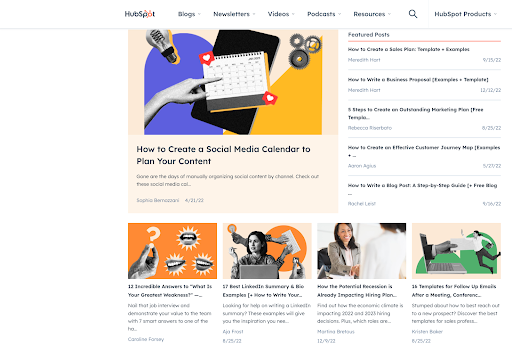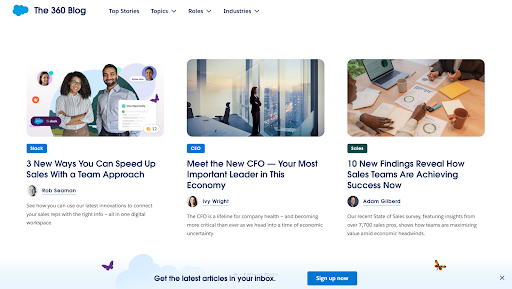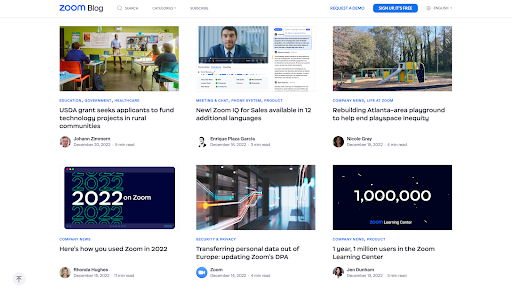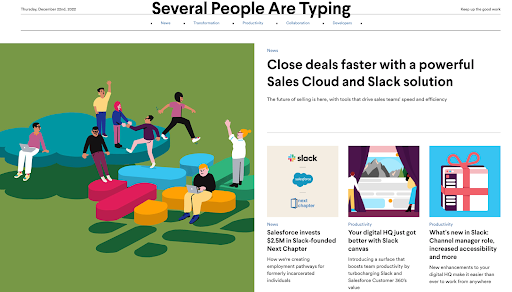Have you ever felt like your B2B blog is just a tiny drop in the ocean of online content? Don’t worry, you’re not alone! With so much competition out there, it can be tough to make your blog stand out and capture the attention of your audience. But just like a drop of water can create ripples and make a big impact, a well-crafted B2B blog post can make a huge difference in your business — from increasing brand awareness to driving traffic and conversions.
So, if you’re looking for some inspiration for your own B2B blog, look no further! In this post, we’ll showcase some of the most noteworthy B2B blogs out there and discuss what makes them so effective. From in-depth industry analysis to helpful tips and tricks, these blogs have it all. By taking a closer look at these examples, you can get a better sense of what works in the world of B2B blogging and start crafting your own successful B2B content marketing strategy.
So, let’s dive in and explore some of the features the best B2B blogs boast — or skip straight to the examples here.
The Importance of Blogging for B2B Companies
Well, the importance of blogging can’t be overstated: With the right content strategy, your blog can help you build trust with your audience and establish your brand as the go-to source for your industry’s news and trends. Of course, this all translates into more leads, customers and revenue.
And it doesn’t stop there: Blogging can also help you attract new talent and strengthen your company’s internal culture by giving employees a way to share their knowledge and expertise with the world. So, no matter what stage of growth you’re in or what industry you serve, blogging can help your B2B company get the results you want.
B2B vs B2C Blogs: What’s the Difference?
The target audiences make these two types of blogs unique and require different types of content. Here are some marketing collaterals that fit the bill for B2B blogs:
- Articles: If you’re running a B2B blog, articles are one of the best ways to build trust and authority with your audience. You can write valuable content about industry trends, best practices and share expert insight on specific topics. The key is to be authoritative, but not overly promotional. After all, your audience is already interested in what you have to say — that’s half the battle won!
- Guides: Let’s be honest, no one reads long manuals anymore, and your B2B customers are likely not the exception. By publishing guides and educational content about how to use your products, you can help your audience find the answers to their query quickly and easily.
- Case studies: What’s better than a real-life example of how your solution helped one of your customers? Case studies are a great way to demonstrate the value of your product or service and give your audience a taste of what they can expect from you.
- eBooks: If you’re not already publishing eBooks, now’s the time to get on board! eBooks are a great way to provide more value to your audience in an easily digestible format that can be read at their leisure. When thinking of a topic, prioritize addressing your consumers’ pain points and providing them with actionable solutions.
- Infographics: There are all kinds of audiences out there, including those who prefer to consume information visually. Capture their attention with a visually-appealing infographic that presents your data in an easy-to-understand format.
Subscribe to
The Content Marketer
Get weekly insights, advice and opinions about all things digital marketing.
Thank you for subscribing to The Content Marketer!
4 B2B Companies That Are Nailing the B2B Blogging Game
When it comes to blogging, there are a lot of B2B brands doing it right. Whether they’re writing about industry trends, product updates or software-related news, these companies are all shining examples of how B2B companies can use their blogs as valuable marketing tools.
But before we dive into what makes each of these B2B blogs worthy of a mention let’s explain some of the things that every B2B blog should have:
- A consistent schedule.
- Well-written content that’s free of grammar and spelling mistakes.
- Engaging, relevant and actionable content.
Now that we’ve gone over the basics, let’s get into the B2B blogs that are setting themselves apart from the rest:
1. HubSpot

HubSpot’s blog is a standout example of a B2B blog that provides valuable and relevant content to its target audience. It covers a wide range of topics that are of interest to professionals in the B2B space, including marketing, sales, customer service and business operations. The articles are well-researched and written by experts in their respective fields, providing readers with accurate and useful information that they can apply to their own businesses.
In addition to the written content, the blog also includes podcast episodes, which allow readers to learn about relevant topics in an audio-based format. The blog also offers free courses and certifications, allowing readers to further their education and improve their skills in a specific area. And for those looking for practical tools and resources, HubSpot also includes templates that can be easily downloaded and customized for use in their B2B company.
The blog itself is visually appealing, with clear and concise headlines, and attractive images and graphics. Its user-friendly design and navigation make it easy for readers to find and access the articles they’re interested in. And with new content being published on a regular basis, readers can count on always having something new to read.
Overall, the variety and quality of the content on HubSpot’s blog make it a valuable resource for professionals in the B2B space looking to stay up-to-date on the latest trends and best practices in their field. Whether they’re looking for in-depth articles, podcast episodes, educational content or practical resources, HubSpot’s blog truly has something for everyone.
2. Salesforce

The Salesforce blog has got to be one of the most organized and well-designed blogs in the B2B space. It’s easy to find what you’re looking for, whether it’s an overview of the latest developments in technology or a detailed breakdown of how your company can benefit from one of Salesforce’s products.
Not only do they have different categories for what they cover, but readers can also filter by the role they have in their company, the industry they’re in and the content type they prefer. In addition, as users scroll, they’re presented with a variety of B2B content that’s presented with a title, image, description and tag to identify what the article is about. This allows readers to quickly scan through the page and find exactly what they’re looking for.
Their tone is professional, yet it gives readers a sense of comfort that they aren’t being talked down to — which is crucial in the B2B marketing arena because the customers they’re targeting are very intelligent and well-educated individuals.
Another element that Salesforce got right is that they use their blog for purposes other than solely promoting their product. They publish valuable content that speaks to the pain points of their audience with titles such as “How Customer Service Teams Can Lower Costs and Deliver Quality at Scale” and “No One Understands Your Charts — Here’s How To Change That”. This makes the blog a go-to resource for professionals who need to get up to speed on a topic, and in turn, helps Salesforce position itself as an authority on the subject — a great inbound marketing strategy.
3. Zoom

The Zoom blog has been successful beyond just being a resource for the company’s customers. Of course, there are blog posts geared towards helping people understand how to use Zoom’s products, but they also use their blog to highlight their employees and share customer success stories. In doing so, they humanize the brand and make readers feel as though they’re part of a community while simultaneously building credibility and positioning themselves as thought leaders in the space.
They gained massive popularity during the pandemic as more people turned to remote work and relied on video conferencing to stay connected. However, Zoom has managed to stay relevant and continues to innovate even after the pandemic subsided, which is evident in the diverse range of topics covered in their blog content.
From tips on how to solve core revenue challenges and sharing their vision for modern financial services institutions, to celebrating Hispanic Heritage month and explaining how fashion brands can host castings through their platform, the Zoom blog is an excellent example of a B2B blog that showcases the company’s versatility and helps it connect with a wide range of audiences.
Moreover, in addition to being a great source of information and inspiration, the Zoom blog is also optimized for conversions and social media sharing. They have clear calls to action throughout the blog that encourage readers to try out their products and sign up for free trials.
The blog is also designed to be visually appealing and easy to navigate, making it a pleasant and engaging experience for readers. And, with social media sharing buttons prominently displayed on each post, it’s easy for readers to share their favorite articles with their network. All of these features make the Zoom blog not only a valuable resource for readers but also a powerful B2B marketing tool for the company.
4. Slack

Slack’s B2B blog is a valuable asset for the company as it helps to establish and maintain a strong brand identity. One of the key elements that make Slack’s blog so effective is consistency in its bright visual style and lighthearted tone, which reinforces the brand’s overall aesthetic and personality. The content on the blog is always relevant to the company’s target audience, which is primarily made up of business professionals, and this focus on relevance helps to keep readers engaged and coming back for more.
And with over 60 pages of content, the blog is a treasure trove of information for readers. To help people find what they’re looking for, the company has introduced an interactive element in the form of a pop-up that allows visitors to quickly filter content by topic and enhances the user experience.
Another aspect that contributes to the success of Slack’s blog is its authenticity, as posts often feature personal anecdotes and stories from employees, which helps readers to feel like they’re getting an inside look into the company’s culture. This is a great way to build trust, as it shows that Slack is not simply trying to sell its product — it actually cares about the people who use it.
How B2B Blogs Complement Your Broader Marketing Strategy
When you look at the marketing landscape, it’s easy to see that content is king. Content is everywhere — and when done right, there’s no end to its value. B2B blogs are a great way to add value to your marketing efforts. They give you an opportunity to expand your reach, build relationships with prospects and customers, and increase awareness of your brand.
What’s more, by consistently publishing valuable, informative content, you can demonstrate your expertise and position your brand as a go-to resource for information and solutions. This helps build credibility and trust with your target audience, which ultimately leads to increased sales and customer loyalty.
They’re also used to drive traffic to your website and other marketing channels. By optimizing your blog posts for relevant keywords, you can improve your search engine rankings and attract more qualified traffic to your site. This can be especially useful for attracting new leads and nurturing them through the sales funnel. And finally, B2B blogs are great at supporting other marketing initiatives and campaigns — they can be used to promote events, webinars, or other content that you have created.
Are B2B blogs a long-term strategy that requires a lot of time and effort? Yes. But are they worth it? Absolutely.





